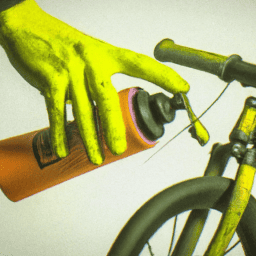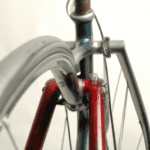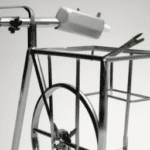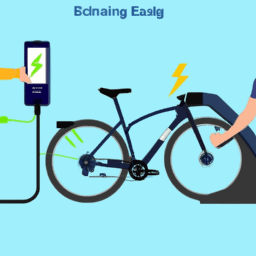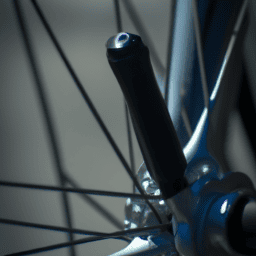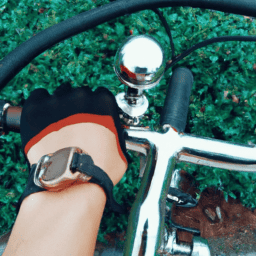Redoing the paint job on a bicycle can dramatically transform an aged and tired-looking bike into something that appears fresh off the assembly line. It’s akin to providing your reliable ride with a rejuvenation that not only enhances its look but also prolongs its service life. While this might seem like a daunting challenge, armed with the appropriate tools and methods, it’s an endeavor within reach for anyone.
Before you begin, gather all the necessary materials and tools, including sandpaper, primer, paint, and clear coat. You’ll also need some basic bike tools to disassemble and reassemble your bicycle, such as wrenches, screwdrivers, and pliers.
With these in hand, you’ll be ready to give your bike the makeover it deserves. So, let’s dive into the process of repainting your bicycle and see how easy it can be with a little bit of elbow grease and some patience.
Key Takeaways
- Repainting a bike can make it look brand new and extend its lifespan.
- Materials and tools needed include sandpaper, primer, paint, clear coat, and basic bike tools.
- Steps for repainting a bike include choosing metal-specific paint, sanding away old paint and rust, disassembling the bike, cleaning the frame, applying primer, reassembling the bike, and experimenting with custom paint designs.
- Maintenance tips include keeping the bike clean and dry, lubricating the chain, checking brakes, and inspecting tires.
Gather Your Materials and Tools
Now it’s time to gather all the materials and tools you’ll need to give your bicycle a fresh coat of paint.
To start, you’ll need to choose the right type of paint for your bicycle. There are many types of paint to choose from, but you should look for one that’s specifically designed for metal surfaces. You can choose from a variety of finishes, including gloss, semi-gloss, and matte.
In addition to paint, you’ll also need sandpaper to prepare the surface of your bicycle for painting. You’ll want to remove any old paint or rust before applying the new coat. Sanding techniques can vary depending on the type of surface you’re working with, so be sure to do your research before getting started.
With these materials and tools in hand, you’re ready to move on to the next step: disassembling your bicycle.
Disassemble Your Bicycle
First, you’ll want to loosen the bolts and screws holding the different components of your bike together. This will allow you to disassemble the bike and prepare it for repainting. Before starting, make sure you have the necessary tools on hand, such as Allen wrenches, screwdrivers, pliers, and a wrench set. It’s also important to take safety precautions, such as wearing gloves to protect your hands and goggles to shield your eyes from any debris that may fly up during disassembly.
Next, begin disassembling the bike by removing the wheels, pedals, saddle, and handlebars. Store the disassembled parts in a safe place to avoid losing any pieces. Use zip ties or small bags to keep the hardware organized and labeled so you can easily put the bike back together when it’s time.
Storing the parts in a logical order will also help you avoid confusion and save time in the long run. With the bike fully disassembled, you can now move on to prepping the frame for painting.
Prep Your Frame
To get your frame ready for a fresh coat of paint, you’ll want to make sure you thoroughly clean it with a degreaser and sand away any rust or rough patches that may interfere with the new finish. This may seem time-consuming, but it will ensure a smoother and longer-lasting paint job.
Start by removing any components or accessories that may still be attached to your bike frame, so that you can focus on the frame itself. Use a degreaser to remove any dirt, oil, or grime that may be present on the frame. Rinse the frame with water and let it dry completely before moving on to the next step.
Next, use sandpaper grit to remove any rust or rough patches on the frame. Start with a coarse grit sandpaper and then move on to a finer grit sandpaper to smooth out the surface. Be sure to pay extra attention to any areas where the paint has chipped or peeled off.
Once you have sanded the entire frame, wipe it down with a clean cloth to remove any dust or debris. You can now apply a primer to the frame to ensure that the new paint adheres properly. There are many primer options available, so choose one that is appropriate for your frame material and the type of paint you will be using.
By now, you should have a clean, smooth, and primed bike frame, ready for its new coat of paint. With the prep work out of the way, it’s time to reassemble your bicycle and get it back on the road.
Reassemble Your Bicycle
After completing the prep work, it’s time to put everything back together and enjoy your sleek, new ride. But before you start reassembling your bicycle, make sure that all the parts are clean and free from dirt and debris. This will ensure that everything fits together properly and that you won’t have any issues with misaligned parts.
When reassembling your bicycle, it’s important to pay attention to the torque specifications for each bolt and screw. Using a torque wrench will help you ensure that everything is tightened to the correct level, preventing any potential issues down the road. Additionally, be sure to lubricate all moving parts, such as the chain, derailleur, and brake calipers.
This will not only help to prevent rust and corrosion, but it will also help your bike to shift and brake smoothly. With proper lubrication and torque, your bike will feel like new again.
Now that your bicycle is reassembled and in working order, it’s time to move on to the finishing touches.
Finishing Touches
Now that I’ve finished painting my bicycle, it’s time to move on to the finishing touches.
First, I need to remove the masking tape and newspaper from the areas I covered earlier.
Next, I’ll carefully inspect the bike for any smudges or mistakes, and clean them up with a damp cloth or sandpaper if necessary.
Finally, I can step back and admire my handiwork, enjoying the satisfaction of a job well done.
Remove masking tape and newspaper
Congratulations! You can finally peel off the masking tape and newspaper from your freshly painted bicycle, revealing its stunning new look. But before you throw away those scraps of paper and tape, make sure to follow these steps to avoid any damage to your new paint job:
-
Use a sharp blade or a pair of scissors to carefully cut the tape along the edges of your paint job. This will prevent any peeling or chipping of the new paint.
-
Once the tape is removed, inspect your bicycle for any smudges or mistakes that may have occurred during the painting process. If necessary, use sandpaper to smooth out any rough areas.
-
Clean up any excess paint or debris using a damp cloth or sponge. Be careful not to rub too hard, as this could damage the new paint job.
-
Finally, take a step back and admire your newly painted bicycle!
Now that you’ve removed all the tape and paper, it’s time to move on to the next step: cleaning up any smudges or mistakes.
Clean up any smudges or mistakes
To clean up any smudges or mistakes, you’ll need to grab a damp cloth or sponge and gently wipe away any imperfections. This is an important step in the process because even the smallest smudge can ruin the overall look of your newly painted bicycle.
Don’t be afraid to take your time and go over the entire surface, making sure that everything looks perfect. If you notice any scratches or imperfections that can’t be wiped away with a damp cloth, don’t worry.
You can easily fix these issues by sanding down the affected area and applying a touch-up coat of paint. This is also a good time to choose any additional paint colors you may want to add to your bicycle, such as stripes or accents.
Once you’re happy with the overall look of your bike, it’s time to move on to the final step and enjoy your newly painted bicycle!
Enjoy your newly painted bicycle!
Get ready to ride your freshly painted bike and show it off to all your friends! But before you hit the road, it’s important to keep your newly painted bicycle in top condition.
Maintenance tips include keeping it clean and dry, lubricating the chain, checking the brakes, and inspecting the tires for wear and tear. By taking care of your bike, you’ll ensure it stays looking great for years to come.
If you’re feeling creative, you can also experiment with custom paint designs to make your bike truly unique. From simple stripes and patterns to more intricate designs, the possibilities are endless.
Just remember to use high-quality paint and take your time to achieve the desired results. With a little patience and practice, you can turn your bicycle into a work of art that reflects your personal style. So go ahead and let your imagination run wild – the end result will be worth it!
Frequently Asked Questions
How long does the repainting process usually take?
The duration of the repainting process can vary based on the size of the bicycle and complexity of the design. However, proper preparation is crucial for a successful paint job. Common mistakes to avoid include not cleaning the bike thoroughly and rushing the drying process.
Can I use any type of paint for my bicycle?
I wouldn’t want to paint a bullseye on my back, so I always choose suitable paint for my bike. When preparing the surface, I suggest using sandpaper and cleaning agents. Be mindful of the weather, as it can affect the paint’s drying time.
Is it necessary to remove all the parts from the bicycle before painting it?
It is not necessary to remove all parts before repainting a bicycle, but it is recommended. Pros of leaving parts on include saving time and avoiding potential damage from removing and reassembling. However, tips for protecting parts during repainting include covering them with tape or plastic wrap.
How do I ensure that the paint job will last a long time?
To ensure a long-lasting paint job, proper paint preparation is key. Start by thoroughly cleaning and sanding the surface. Apply a primer and let it dry before adding the final coat. Regular maintenance tips include storing the bike indoors and cleaning it regularly.
Can I paint over rusted areas on my bicycle or do I need to remove the rust first?
To prevent rust from spreading, it’s best to remove the rusted areas before painting. Rust prevention techniques like primers and rust converters can also help. Alternative paint options like powder coating can provide added protection against rust.
Conclusion
Well folks, I hope you’ve enjoyed my detailed and technical guide on how to repaint your bicycle. I know you’re all dying to get out there and show off your new color scheme, but before you do, let me give you a few final tips.
First off, don’t forget to wear gloves and a mask while painting. You don’t want to end up with a new shade of paint on your skin or in your lungs.
And speaking of paint, don’t skimp on quality. Trust me, you don’t want your beautiful new paint job to start chipping away after just a few rides.
Lastly, if all else fails and your paint job turns out to be a disaster, don’t worry. Just tell everyone it’s a new avant-garde style and that you’re a trendsetter. Who knows, maybe you’ll start a new fashion craze.
Keep on pedaling, my friends!
